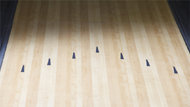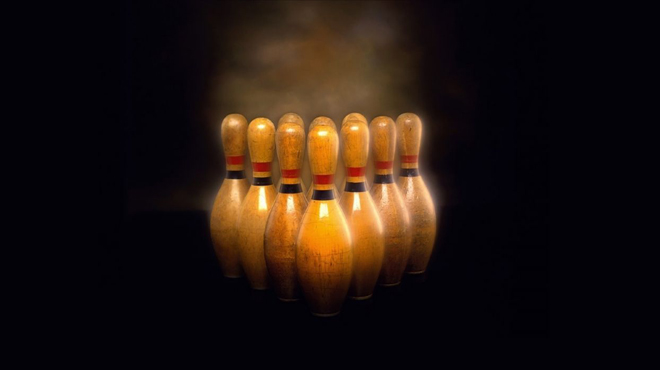Memory Lane: A pin boy's tale

 You know bowling is big when you’re as likely to find lanes inside the local bar as you are in the church up the street. That’s how it was for Gary Helfrich, who grew up setting pins at the churches and bars of Buffalo as a kid in the 1950s for the rich sum of 11 cents a game. And he has the scars to show for it.
You know bowling is big when you’re as likely to find lanes inside the local bar as you are in the church up the street. That’s how it was for Gary Helfrich, who grew up setting pins at the churches and bars of Buffalo as a kid in the 1950s for the rich sum of 11 cents a game. And he has the scars to show for it.
“I had broken ribs from getting hit with pins, smashed fingers, and, of course, your shins were always banged up,” recalls the now 67-year-old Helfrich, who has bowled for more than 50 years. “You earned your eight bucks a night, that’s for sure! You had to watch for the wise guys who threw the ball 100 miles an hour just to see if they could make the pins fly. You only have two eyes, but there are 10 pins.”
In the distant past Helfrich visits in his memory, eight bucks a night is a king’s fortune. The Cokes rowed in the vending machines at those churches and bars are yours for a dime, a cup of coffee at Deco’s restaurant costs you a nickel, and the gallon of gas you burn to get there sets you back no more than 22 cents.
“My first bowling ball was $29!” Helfrich says.
It’s a place in time where you still oil the lanes with a mop and a spray can, and the kids setting pins for soda money learn a thing or two about the temptations that come with a buck.
“Sometimes guys would come up to me and say ‘Hey, if you give me a 300 game I’ll give you $100,’” Helfrich recalls with a chuckle. “I couldn’t do that; my father would have murdered me. They’d say ‘Just take a coat hanger back there.’”
But no one had to sneak any coat hangers back to the pin pit to make an extra piece of change, not if you stuck around long enough for someone to bowl a big game and toss you a tip in return. And as long as no one’s father threatened to murder them for it, the real money came in the form of late-night pot games on the weekends, when the owner promised to keep the lights on as long as the bowlers promised to pay the pin boys themselves.
More often than not, the lights stayed on until four or five in the morning.
“They paid us and tipped us and we made pretty good tips doing that,” Helfrich remembers. “They’d keep bowling for hours and hours. I remember thinking ‘How can these guys afford this? They’ve got kids and families!’ But it wasn’t big bucks like it is today. Today when I pot bowl, it costs maybe $40 or $50. Back then it was five or 10 bucks.
“Another job I had at the bowling alley at the church was to dress the lanes between shifts,” he recalls. “You had a bug sprayer with oil in it and you’d just spray it on the lane and then take a mop and go up and down the lane with it to even it out.”
By the time Helfrich left those four lanes in the back of the local bar for work at the lanes inside the church, he discovered a technological wonder that was as much a marvel then as it is a relic today: the semi-automatic pinsetter.

“You set up the pins in the rack, and then you pulled this big lever down and it would set the pins,” Helfrich recalls.
But every pin boy knew that the real work was not done during Friday night pot games or lazy Saturdays when the occasional bowler wandered in for a few games of practice. The real work was done manning two lanes at a time during league nights, when the pins kept flying for hours on end and you emerged from the pin pit so drenched in sweat you looked like you’d gotten caught in a downpour.
“You’re moving constantly, especially if you’re running two lanes,” Helfrich recalls of those relentless nights setting pins for leagues. “I ran two lanes for two years—two bowling seasons. We’d come out of there and the sweat would just be rolling off of you. There was no air conditioning back there in those days. But when you’re 14 or 15 years old, you know, you’re indestructible.
“But we all loved it. It wasn’t like ‘Oh, God, I gotta do this!’ We enjoyed it. I worked three nights a week and made $8.90 a night. That’s $26 a week I was making. There was another house above a movie theater that had 12 lanes and it was just three blocks from my house, but I never could get a job there because nobody ever quit! They never needed a pin boy.”
A lot has changed since the days of 10-cent Cokes and semi-automatic pinsetters. Helfrich went on to put in 34 years of service to the U.S. Navy and is enjoying his retirement in Winter Haven, Fla. That $8.90 a night he once earned in the pin pits of Buffalo would hardly buy him a couple of gallons of gas today, no one’s buying bowling balls for $29 anymore, and his former salary of $26 a week won’t do much to entertain you today if you’re a 15-year-old kid looking for something to do on a Saturday night.
“You know, our idea of fun was renting a canoe for a dollar a day and going down the canal with a couple of your buddies,” Helfrich remembers. “Of course, there was no such thing as cell phones and iPads and all that stuff.”





